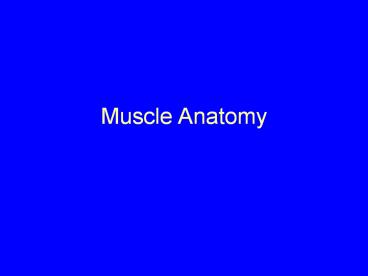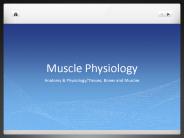Muscle Anatomy - PowerPoint PPT Presentation
1 / 10
Title:
Muscle Anatomy
Description:
Muscle Anatomy Outer part of skeletal muscle: Tendon: At the end of muscle fibers. Attach the muscle to the bone. Fascia: Dense connective tissue covering entire muscle. – PowerPoint PPT presentation
Number of Views:56
Avg rating:3.0/5.0
Title: Muscle Anatomy
1
Muscle Anatomy
2
Outer part of skeletal muscle
- Tendon
- At the end of muscle fibers.
- Attach the muscle to the bone.
- Fascia
- Dense connective tissue covering entire muscle.
- Fascia is a continuation of the tendon.
Muscle
Bone
Tendon
Fascia (covering muscle)
3
The various bundles of muscle
- Each muscle is made of individual bundles of
muscle sections. - This is in order from the smallest section to the
largest. - Myofibrils
- Contractile fibers within muscle cells.
- Play a fundamental role in the muscle contraction
mechanism. - Muscle Fiber
- Several Myofibrils bundled together.
- Fascicles
- Several Muscle Fibers bundled together.
- Every muscle in the body is made up of several
fascicles bundled together.
Muscle
Fascicles
Muscle fibers (cells)
Myofibrils
Fascicle
Myofibril
Muscle fiber
4
Layers of connective tissue
- Epimysium
- Most superficial layer of connective tissue.
- Surrounds all of the fascicles (or the entire
muscle). - Located under fascia.
- Perimysium
- Middle layer of connective tissue.
- Surrounds each fascicle (or several muscle
fibers). - Endomysium
- Deepest layer of connective tissue.
- Surround each muscle fiber (or several
myofibrils).
Muscle
Fascicles
Muscle fibers (cells)
Myofibrils
Epimysium
Perimysium
Endomysium
5
Muscles Fibers are Cells!!!
- Muscles are made of cells.
- The Muscle Fibers section of a muscle are the
cells. - This is one of the 260 different types of
specialized cells. - Thus they have the same properties as cells.
- Sarcoplasm
- Another term for cytoplasm inside muscle cells.
- Contains nuclei and mitochondria.
- As you can see, muscles have A LOT of
mitochondria. Why? - NEED ATP!!!
Nucleus
Mitochondria
Sarcoplasm
6
Anatomy of Muscle Fibers (cells)
- Sarcolemma
- Cell membrane surrounding several myofibrils.
- Sarcoplasmic Reticulum
- Membranous network of channels and tubules with
muscle fiber. - Myofibrils
- Contractile units.
Muscle
Fascicles
Muscle fibers (cells)
Myofibrils
Myofibril
Sarcoplasmic reticulum
Muscle fiber
Sarcolemma
7
Sarcoplasmic Reticulum
- Transverse tubules (T-tubules)
- Membranous channel that extends inward.
- Cisterna
- Enlarged portion of the sarcoplasmic reticulum.
- Triad Three structures T-tubules and Cisterna
Cisterna
Triad
Transverse tubule
Sarcoplasmic reticulum
Openings into transverse tubules
8
Anatomy of Myofibrils
- Sarcomeres (very important!!!)
- Structural and functional unit of a myofibril,
where the contraction actually happens. - Myofibrils are actually sarcomeres joined end to
end.
Sarcoplasmic Reticulum
Myofibril
Sarcomere
9
Muscle Structure Flowchart
Muscle
Surrounded by Fascia
Surrounded by Epimysium (deep to Fascia)
Fascicles
Each one is surrounded by Perimysium
Muscle Fibers (a.k.a. muscle cells)
Each one is surrounded by Endomysium
Myofibrils
Sarcomeres (contractile units, IMPORTANT)
10
Muscle Fibers (a.k.a. muscle cells) Flowchart
Muscle Fibers (a.k.a. muscle cells)
Each one is surrounded by Endomysium
Sarcolemma (cell membrane)
Sarcoplasm (cytoplasm)
Nuclei
Mitochondria (has a lot to make a lot of ATP)
Sarcoplasmic Reticulum (houses calcium)
Myofibrils Key Sarcomeres make up myofibrils The
sarcomere is the contractile unit. Very
important!!!































